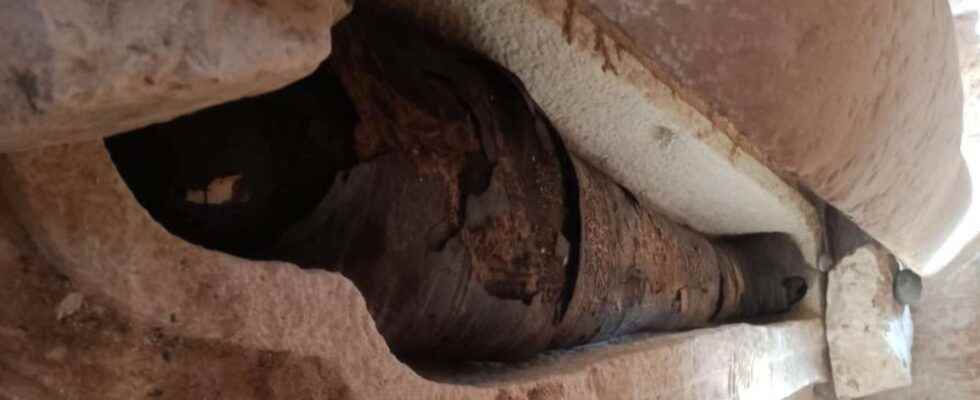The mummies of a man and a woman were found south of Cairo. The man’s tomb had never been opened since the mummification, and the tongues of the two mummies were covered with a golden tongue.
You will also be interested
[EN VIDÉO] The mystery of the alignment of the pyramids finally solved? How did the engineers of ancient Egypt manage to align the pyramids of Giza with such precision along the four cardinal points? A researcher may have finally found the answer.
Archaeological excavations have been carried out at the Meniya site named El-Bahnasa (formerly Oxyrhynchus), which is located just over 200 kilometers south of Cairo, Egypt. Two sarcophagi were discovered, they contain the mummies of people still unknown and date from 2,500 years ago, when the country was under the rule of the Saite dynasty. The woman’s sarcophagus had been opened in the past, but the man’s remained intact, which is an exceptional find. A golden tongue had been placed in the mouths of the two mummies and three other languages were found outside the sarcophagi, one of which belonged to a young child as well as amulets. From figurines funeral and canopic jars in which the internal organs of the mummies were placed.
A not so unusual practice
The last discovery of gold tongues placed with mummies dates back to February 2021 when archaeologists found gold tongues placed in mummies at Taposiris Magna, west of Alexandria. According to archaeologists, placing golden tongues with the mummies allowed the deceased to speak with them. Osiris, the god of the Hereafter who sits at the tribunal of the dead and allows them to access eternal life or not.
Finds of Greco-Roman mummies with golden tongues
Article from the Editorial Board of Futura, published on 02/04/21
On the Taposiris Magna site, a research team has just discovered sixteen burials 2,000 years old. Among the various artefacts that surrounded them, the most surprising are surely the golden tongues that have been found in the mouths of many.many of them.
Archaeologists recently made an intriguing discovery at the Egyptian site of Taposiris Magna, west of the Nile Delta. Sixteen characteristic graves from the Greco-Roman era have been unearthed by the research team of Dr Kathleen Martinez, nestled inside stone tunnels. Although most of these 2,000-year-old mummies are now in poor condition, two of them particularly caught the attention of Martinez, who has been exploring the site passionately since 2005, in search of Cleopatra’s tomb.
The first one gate still remains of gold leaf is accompanied by cardboard elements (a mixture of plaster, of linen and glue) representing the god Osiris. The second wears a crown decorated with horns and a cobra starting from the forehead. Her chest is adorned with decorations forming a large necklace, with the falcon’s head as a pendant associated with the god horus. In addition to these gilded cardboard boxes and several rolls accompanying the remains, there are also eight Greco-Roman statuettes in marble, or even golden tongues: amulets that were placed in the mouths of the deceased to allow them to speak when they joined the court of Osiris in the afterlife.
Long-term work
” It should be noted that over the past ten years, the mission [de recherche menée par Kathleen Martinez] made many archaeological discoveries that changed our perception of the temple of Tabosiris Magna, we read in a publication of the Egyptian Ministry of Tourism and Antiquities. A number of pieces bearing the name and image of Queen Cleopatra VII have been found inside the walls of the temple, in addition to numerous fragments of statues and temple elements […] which prove that it was built by the king Ptolemy IV “.
Interested in what you just read?
.
fs3
